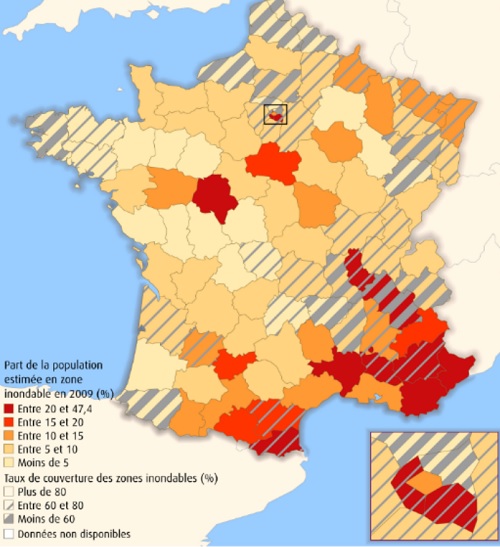Flood Risk Areas in France
Wednesday 04 November 2015
The deaths of 20 people as a result of flooding recently in the Côte d'Azur serves as a tragic reminder of the risk of flooding in certain areas of France.
There are many questions that remain unanswered to explain why storms that took place in the Cannes-Nice basin last month caused so much death and destruction.
Perhaps foremost of those questions is just why development had been allowed to take place in areas that were known to be at risk of flooding.
No doubt certain local politicians of dubious character or competence ignored the advice they were given and proceeded to allow new construction they knew was a risk.
However, their infidelity and negligence have been aided by the historic lack of a clear legal and planning framework.
Although there are controls on development in areas of flood risk, an unambiguous preventative framework has only been on the statute book since 1995.
Since this time local planning authorities have been obliged to prepare a local risk prevention plan, called Plans de Prévention des Risques d'Inondation (PPRI).
These plans divide the area into three planning zones:- Red Zone – No development permitted
- Blue Zone – Development permitted subject to particular conditions
- White Zone – Development permitted subject to local planning regulations
All the councils in those areas affected by the recent floods have in place a risk prevention plan, but such plans can do little about development that has taken place before it was created, so that those properties in the most exposed areas continue to be at risk.
It also has to be acknowledged that the storms that raged over the Côte d'Azur were of an unprecedented level, against which the local authorities and rescue services were powerless.
Elsewhere in France some local authorities have still to prepare such plans, despite that fact the risk of flooding in France has increased, with no less 14 major flooding disasters in all parts of the compass over the past 15 years.
According to government statisticians 11% of the country is at risk of flooding, which affects in some measure all departments in the country, and one in two communes.
The number of homes at risk of flooding is nearly 4 million, around 90% of which are second homes in coastal areas.
However, in the vast majority of cases the level of risk is low, with most parts of the country having substantially less than 10% of their population at risk.
The image below (although now a little out of date) shows those areas most at risk, but do not assume from the colouring that whole of the areas in red are at substantial flood risk, where no development is permitted; they are merely the administrative areas with the greatest flood risk. The diagonals on the image indicate the level of coverage by a PPRI.
Worst affected is the South East, where in the Gard department 44% of the population is at risk of flooding. In the Vaucluse department 40% of the population are at flood risk, in Alpes-Maritimes it is 30%, 24% in Alpes-de-Haute-Provence and 26% in the Var.
Beyond the South-East into Languedoc-Roussillon region the Pyrénées-Orientales (40%) and Aude (21%) have the largest population at risk.
In the Rhone department 40% of the population have a flood risk, whilst it is 18% in neighbouring Haute-Alpes.
Further north, with the largest populations at risk are Indre-et-Loire (29%) and Isère (29%).
Once again, however, there are different levels of risk in these areas, from low to high, which are elaborated in the local risk prevention plan.

Risk Reports on Property Purchase
If a property is located within a risk zone (whether related to flooding or other natural or industrial risk), as part of the sale process of a property the seller is required to notify the purchaser.
The information will be included in the home information pack, called the dossier de diagnostics immobiliers.
The same applies to properties being let, where the landlord is required to provide the prospective tenant with a risk report if the property is located within a risk area.
However, as there is yet to be complete coverage of the country by such plans, it is possible that in some cases there will be no such report.
It is highly unlikely that a property located in a zone at a high risk of flooding will not be now be covered by an risk plan, either completed or in the process of preparation, but if there is any doubt about the level of the risk purchasers should make formal enquiries of the seller, the notaire and the local council.
Next Article: Auto-Entrepreneur or Regime Reel?
Thank you for showing an interest in our News section.
Our News section is no longer being published although our catalogue of articles remains in place.
If you found our News useful, please have a look at France Insider, our subscription based News service with in-depth analysis, or our authoritative Guides to France.
If you require advice and assistance with the purchase of French property and moving to France, then take a look at the France Insider Property Clinic.





